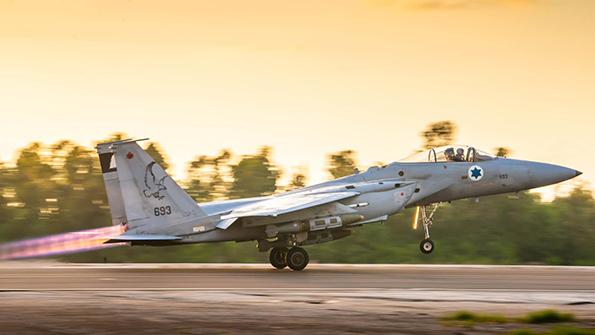
An Israeli F-15A Baz fighter in 133 Sqdn. colors took off on a mission during Operation Swords of Iron in Gaza, carrying at least two Joint Direct Attack Munitions.
A Belgian-flagged Boeing 747 commercial freighter landed at Nevatim air base, Israel, on Oct. 11 carrying one of the first shipments of U.S.-built munitions rushed to the world’s newest war zone.
Additional shipments from the U.S. are likely to continue arriving in Israel for weeks or months to come, adding further pressure on a munitions industrial base straining to meet the demands of U.S. aid to the Ukrainian military and the Defense Department’s dwindling stockpile of munition reserves.
Tens of thousands of Israeli troops were massed along the border of Gaza as this article went to press, readying for a land invasion of the densely populated Palestinian territory. Meanwhile, Israeli fighter jets and artillery pounded hundreds of targets inside Gaza and as far away as the airports of Aleppo and Damascus in Syria. Hamas-controlled forces had shocked the Israeli military on Oct. 7 by launching a multidomain, cross-border assault on dozens of remote settlements and military bases. The terrorizing surprise attack killed more than 1,000 civilians and 200 Israeli troops, triggering several days of Israeli airstrikes that have killed hundreds more in Gaza.
- U.S. shipments started arriving in Israel Oct. 11
- Israeli exports could be pressured by prolonged conflict
In response, U.S. officials surged naval and air forces to the region and pledged to supply Israel with whatever it needs to execute a war that threatens to spread beyond Gaza, as reports grew of sporadic violence in the West Bank and Hezbollah’s strongholds in southern Lebanon.
“We’ll continue to ensure that Israel has what it needs to keep itself and its citizens safe,” U.S. Defense Secretary Lloyd Austin said Oct. 11.
Austin spoke to reporters about efforts to support Israel at the latest Ukraine Defense Contact Group meeting, which gathered in Brussels Oct. 11 to be briefed on Kyiv’s specific needs for weapons by Ukrainian President Volodymyr Zelenskyy.
The U.S. has shipped $43.9 billion worth of military equipment to Ukraine since Russia launched its full-scale invasion in February 2022, including more than 2 million artillery rounds alone. Sending more aid to Ukraine, however, may depend on breaking an impasse over who will be the next Republican speaker of the House of Representatives.
Enough residual funding remains to keep U.S. equipment flowing to Kyiv through the end of December, Gen. Charles Q. Brown, Jr., chairman of the Joint Chiefs of Staff, told reporters in Brussels. The White House approved an additional $200 million in military aid for Ukraine on Oct. 10.
With congressional appropriations for fiscal 2024 logjammed by the House Republican leadership impasse, U.S. Army officials pleaded for lawmakers to approve legislative proposals to surge munitions spending.
“We need the support of Congress to replenish critical stockpiles of munitions and equipment,” Army Secretary Christine Wormuth said in an Oct. 9 speech that opened the Association of the U.S. Army’s (AUSA) Annual Meeting. Wormuth, however, noted that the drain on the American stockpile to support Ukraine is worth it because it weakens Russia’s military.
Although some munitions suppliers are struggling to keep up with existing demand from Ukraine and the U.S., there are signs that supporting Israel in the Gaza conflict will not add significantly to the industrial burden.
So far, the U.S. has simply fast-tracked deliveries of certain munitions from previous orders placed by Israel, a senior U.S. defense official told reporters at the Pentagon Oct. 9. “What we’re looking at is what was already on the books,” the official said. “And we’re working to accelerate that.”
The nature of Israel’s needs for munitions may also be fundamentally different than Ukraine’s. The first shipments to Israel contained munitions that included Tamir missiles, coproduced in the U.S. by RTX for Israel’s Iron Dome air defense system, which has not been supplied to Ukraine. Israel also relies more on airpower to deliver precision-guided munitions than artillery. Finally, Israel has a robust defense industry capable of surging capacity from domestic and international facilities.
“The Israelis do have significant indigenous capacity, so it is a different situation than Ukraine,” Tim Cahill, executive vice president for Lockheed Martin’s Missiles and Fire Control unit, told reporters at AUSA Oct. 9.
If the conflict between Israel, Hamas and perhaps other groups in the region is prolonged, concerns may grow about Israel’s capacity to meet export commitments. Israeli defense industry officials had touted their ability to deliver munitions to foreign customers markedly faster than backlogged alternatives from U.S. and European companies. Those material and human resources may eventually be diverted to backfill Israel’s own stockpiles.

Comments